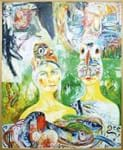
He was born in Germany, but when he was 15 his family emigrated to St Louis in Missouri, an area which attracted many Germans at that time. In 1846 he began to study painting under Louis Pomerade (1807-92), a French artist who had also settled in the city.
In 1852 Wimar returned to Germany and continued his studies at the academy in Düsseldorf. Even there he concentrated on painting scenes from Indian life and he asked his family to send him Indian costumes so that he portrayed them correctly. His Captive Charger was executed in 1854 and sold to the Art Museum of St Louis.
In search of a wild life
Wimar returned to the US in the late 1850s and it was only then that he took part in two expeditions, during which he actually encountered American Indians. In the following years he enjoyed some – sadly short-lived – success. He died of tuberculosis in 1862.
The 13 x 16in (33 x 40cm) study in the Munich sale was less than half the size of the finished picture and was dated 1851(?), which would mean that it was painted while Wimar was still in the US. In 1916 it was auctioned in Munich as part of an aristocratic legacy.
Scheublein’s modest hopes of €6500 in the sale in June attracted a handful of bidders who, slowly but surely, pushed the price up to €115,000 (£100,000), which is the third highest auction price for the artist. The buyer was an international dealer.














